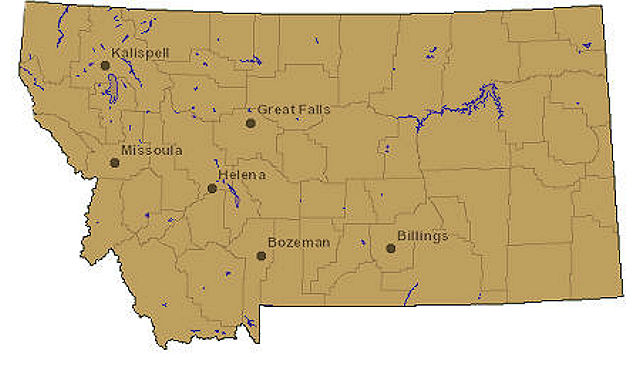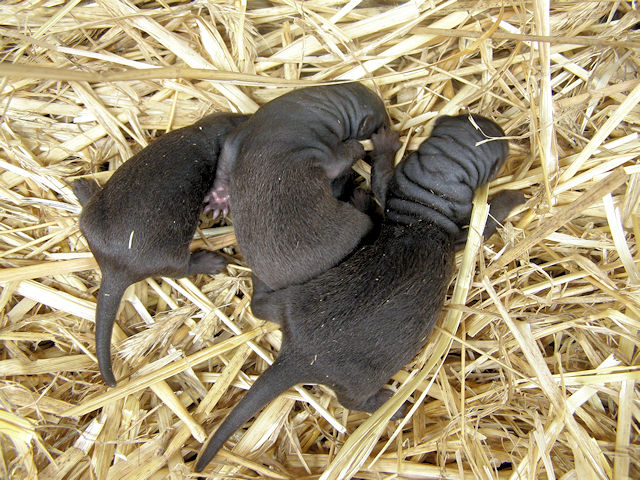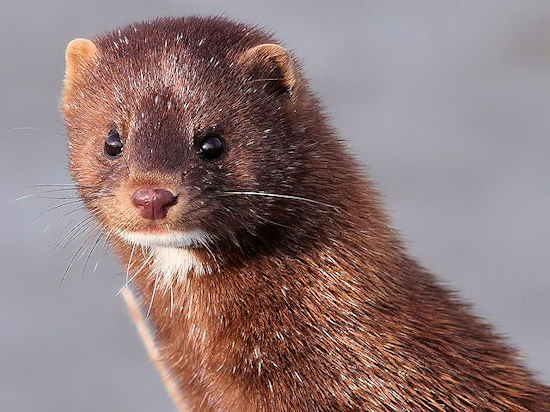Total length: 19 to 28 inches. Weight: 1.5 to 2 pounds.
Habitat: Usually found along streams and lakes. Commonly occurs in marshes and beaver ponds. Permanence of water and dependable source of food are most important habitat components. Often uses den sites of other animals and is commonly found in association with muskrats.
Food Habits: Preys primarily on small mammals, birds, eggs, frogs, and fish. Its diet is almost entirely animal. During summer preys on waterfowl.
Life History: Semi-aquatic forager. Can kill prey larger than itself. Chiefly nocturnal, territorial, and secretive. Dens underneath piles of brush or driftwood, under rocks, in hollow logs, and in houses or dens abandoned by beavers or muskrats. Very aggressive mating behavior. Mates from January through March; 40 to 79 day gestation; delayed implantation; young born during April or May; averages 4 to 5 per litter.
Similar Species: Weasel - has white or yellow underparts. Marten - has buffy patch on throat and breast. River otter - much larger.
Wild mink are adaptable to a wide range of climates, and this species is far more common than most people realize. Efficient predators, mink are quick on land, skilled swimmers, and capable tree climbers. They are often found in habitat types suitable for muskrats, and they are often taken in traps set for muskrats. Mink are usually shy, but they can become bold when their curiosity is aroused. Mink are not sociable with others of their kind, except during the breeding season, and avoidance or fighting between mink is common.
 Description
Description
Mink have 34 teeth, with 4 prominent canine
teeth to help in the killing of prey species.
Mink have rather long and supple bodies with
relatively short legs. There are 5 toes on
each foot which have partial webbing between
toes. Tails are fully furred.
Males are larger than females. Overall lengths of males are 20 to 30 inches, and females measure 16 to 21 inches. Male weights exceed 3 pounds in many areas and females usually weigh 1 1/2 to 2 pounds.
Mink fur is short and dense. Shades of color vary somewhat according to region, and individuals. Most shades of color are chocolate to almost black. Patches of white fur are typical on the chins of most mink, and many mink exhibit patches of white fur on throats, chests and bellies. These small patches are irregular in shape, and vary with the individual. In some areas, occasional mink have a light colored and wooly underfur. This is evident on the lower backs of the mink. These pelts are referred to as "cotton" mink, and these pelts have lesser value.
Mink glands are present near the anal area under the skin of both male and female mink. Musk is sometimes released when the mink is excited or stressed. The odor is powerful and unpleasant.
 Reproduction
Reproduction
Breeding occurs over much of the mink range
during late February or early March. Males
attempt to find several females during this
short season. The males usually abandon
the females after breeding takes place.
Females have one litter per year, usually raising about 4 young. Gestation times vary from 40 to 75 days, due to a delayed implantation process.
Females raise their young entirely by themselves. Dens in abandoned muskrat dens, hollow logs, and rock piles are common. Mink do not usually dig their own dens, but they sometimes burrow into exposed muskrat and beaver lodges above the waterline for denning purposes. Many female mink seem to seek out secluded ponds or small streams with an abundant food supply and good protection to raise their young.
Habits
Male mink have territories or ranges much larger
than females. Males seem to be constantly
on the move, covering miles in a single day.
Females often restrict their travels at night to
20 acres or so in marsh habitats, and they
seldom travel further than 100 years up or down
stream from their dens near rivers or creeks.
The males seem to have routes that might cover 25 miles or more. These males have any number of dens that they use when they are in the area, or feel like resting. It appears that males commonly store food in some of these dens for later use.
Many trappers think that males return from their travels about once a week, and follow nearly the exact same route, crossing streams at the same places, and investigating the same brush piles or undercut banks for food. Holes, hollow logs, rock piles, and brush piles interest many mink as protected places to hunt.
Mink are capable at trailing or stalking prey species, but it appears that they are usually opportunistic feeders who pursue prey after they surprise and startle the prey into flight. Mink hunt and travel mostly at night, but they are occasionally active during the day, especially just before storms or when it is raining or snowing. During periods of extreme cold or deep snow, mink seem to stay near their dens. At times, they will live in dens with underwater accesses and do the bulk of their hunting under the ice.
Mink kill a variety of prey species, including muskrats, crayfish, frogs, rabbits, fish, birds, snakes, grasshoppers, and water beetles. Mink often catch fish and have also been known to enter chicken houses and kill chickens.
Some individual mink appear to kill muskrats with regularity, while other individual mink do not appear to kill muskrats at all. A mature muskrat can surely give a mink a battle in a tight place, or when cornered. Many mink seem to prefer easier and safer prey. However, muskrat seems to be a preferred food for mink, and virtually all mink will scavenge dead muskrats if they are hungry and the meat is fresh. They are capable of catching a muskrat in the water because they use all four feet for propulsion, and the muskrat only uses its back feet for propulsion, with the tail acting more as a rudder. Mink probably service the muskrat resource more than other species by killing weakened or diseased muskrats. Evidence suggests that mink prey heavily upon muskrats when muskrats are diseased, and this may help prevent the spreading of these diseases to healthy individuals.
General
Mink are usually shy and avoid humans, but at
times, exhibit boldness when their curiosity is
triggered.
Although mink are sometimes found traveling or living far from water, most prefer the habitats found along the shores of streams, lakes, marshes, canals, and ponds. Mink usually hug the shores as they travel, and prefer staying on dry land when they have a choice. At times, an obstacle such as a protruding rock or log may cause the mink to detour into the water.
Mink are preyed upon by owls, fox, coyotes, bobcats and dogs. Internal parasites include flukes, roundworms, and tapeworms. External parasites include fleas, ticks and lice. Mink are vulnerable to distemper, parvo enteritis, encephalitis, and rabies.
A 7 year old mink is considered old; and worn teeth are an indication of age.




